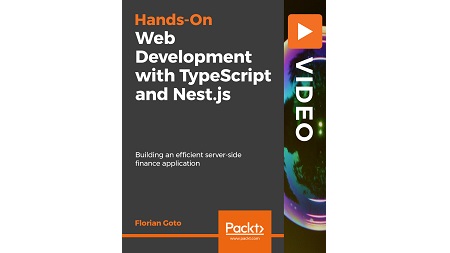
English | MP4 | AVC 1920×1080 | AAC 48KHz 2ch | 3h 35m | 693 MB
Build and deploy efficient, reliable, and scalable full-stack TypeScript applications in Nest.js and Angular
Nest.js is a framework for building Node.js server-side applications on top of TypeScript and JavaScript. It helps to build efficient and scalable web applications and keep your code organized and architecturally flexibile.
In this course, you will learn about the fundamentals of Typescript and Nest.js, together with advanced techniques to build a financial dashboard that will display stock prices, variations, and company-specific financial performance. We will be build a REST API to retrieve the financial data server-side. Later, we will focus on building the front end dashboard using Angular and connect it with the Nest.js REST API to fetch data and display it while also adding authentication and authorization via the server. Finally, we will deploy the app and go live via Heroku.
By the end of the course, you will be proficient in using Nest.js to address issues that Node.js can’t solve and use it to build a full-stack TypeScript application with Angular as your front end framework.
Learn
- Use Nest.js to build more structured server-side applications
- Build a Nest.js REST API that fetches data from the IEX finance API
- Build an attractive and easy-to-use Angular dashboard to display basic financial data
- Integrate a Nest.js back end server with an Angular front end
- Add authentication and authorization on both the back-end and the front-end
- Deploy the app on Heroku
Table of Contents
1 The Course Overview
2 Installing Node.js with NVM and CLI
3 Installing Postman and HTTPie and VS Code with recommended extensions
4 Organizing your server into modules
5 Handling requests and responses with controllers
6 Injecting dependencies with providers
7 Managing the request-response cycle with middlewares
8 Handling all thrown exceptions with exception filters
9 Pipes and Guard
10 Adding Authentication with Passport.js
11 Connecting to MongoDB with Integrated Mongoose
12 Validation with Validation Pipes
13 Security with CORS, CSRF and Helmet
14 HTTP Module with Integrated Axios
15 Setting up the Project
16 Adding Controllers to Handle Requests
17 Adding Providers to get the data from IEX API
18 Injecting Providers to Return data
19 Generating Boilerplate with Angular CLI
20 Creating Dashboard Components
21 Adding Styles with Bootswatch
22 Creating Routes to simulate multiple pages
23 Adding services in the Front-end
24 Fetching data from the REST API
25 Displaying Response data in a User-Friendly Way
26 Authenticating with Nest.js
27 Implementing the Angular Authentication Service
28 Implementing Angular Sign up and Sign in Forms
29 Restricting Angular Views to Logged in Users
30 Building Nest.js server for deployment
31 Deploying the server to Heroku
32 Building the Angular app for deployment
33 Deploying the Angular app to Heroku
34 Course Summary
Resolve the captcha to access the links!